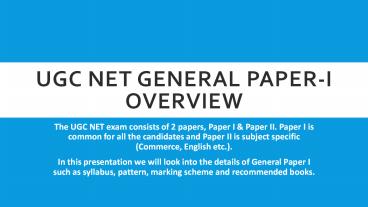UGC NET General Paper-I - PowerPoint PPT Presentation
Title: UGC NET General Paper-I
1
UGC Net General Paper-I Overview
- The UGC NET exam consists of 2 papers, Paper I
Paper II. Paper I is common for all the
candidates and Paper II is subject specific
(Commerce, English etc.). - In this presentation we will look into the
details of General Paper I such as syllabus,
pattern, marking scheme and recommended books.
2
Table of contents
- UGC NET 2020 Exam patternSyllabus for paper 1
General Paper 1 PatternPaper 1 Marking
SchemeList of Important Books for Paper 1
3
ugc net Exam pattern
UGC NET Exam Pattern 2020 Paper 1 Paper 2
Type of Papers Common for all subjects Subject-based paper
Type of Questions MCQ (Multiple choices with a single correct answer) MCQ (Multiple choices with a single correct answer)
No. of Questions 50 100
Marking Weightage 100 (2 marks of each question) 200 (2 marks of each question)
Total Time 3 Hours (180 minutes) 3 Hours (180 minutes)
Questions Based on Topics General Paper on Teaching Research Aptitude Subject related topics
Exam Mode Online (Without any break) Online (Without any break)
Marking Scheme No negative marking No negative marking
4
General paper I Syllabus
- General Paper-I tests the basic aptitude of the
candidates. - The syllabus consists of 10 units which includes
topics like teaching research aptitude,
communication ,reasoning and more. - Lets look at the complete syllabus in detail.
5
unit-I (teaching Aptitude)
- 1. Teaching Concept, Objectives, Levels of
teaching (Memory, Understanding, and Reflective),
Characteristics, and basic requirements.2.
Learners characteristics Characteristics of
adolescent and adult learners (Academic, Social,
Emotional and Cognitive), Individual
differences.3. Factors affecting teaching
related to Teacher, Learner, Support material,
Instructional facilities, Learning environment,
and Institution.4. Methods of teaching in
Institutions of higher learning Teacher centered
vs. Learner-centered methods Off-line vs.
On-line methods (Swayam, Swayamprabha, MOOCs,
etc.).5. Teaching Support System Traditional,
Modern, and ICT based.6. Evaluation Systems
Elements and Types of evaluation, Evaluation in
Choice Based Credit System in Higher education,
Computer-based testing, Innovations in evaluation
systems.
6
unit-II (Research Aptitude)
- 1. Research Meaning, Types, and
Characteristics, Positivism, and Post
positivistic approach to research. - 2. Methods of Research Experimental,
Descriptive, Historical, Qualitative, and
Quantitative Methods, Steps of Research. - 3. Thesis and Article writing Format and styles
of referencing, Application of ICT in
research, Research ethics.
7
unit-III (Comprehension)
- 1. A passage of text is
given. Questions are asked from the passage to be
answered.
8
unit-Iv (Communication)
- 1. Communication Meaning, types, and
characteristics of communication. - 2. Effective communication Verbal and
Non-verbal, Inter-Cultural and group
communications, Classroom communication, Barriers
to effective communication, Mass-Media, and
Society.
9
unit-v (Mathematical reasoning aptitude)
- 1. Types of reasoning Number series, Letter
series, Codes, and Relationships. - 2. Mathematical Aptitude Fraction, Time
Distance, Ratio, Proportion and Percentage,
Profit and Loss, Interest and Discounting,
Averages, etc.
10
unit-vi (logical reasoning)
- 1. Understanding the structure of arguments
argument forms, the structure of categorical
propositions, Mood and Figure, Formal and
Informal fallacies, Uses of language,
Connotations, and denotations of terms, Classical
square of opposition, Evaluating and
distinguishing deductive and inductive
reasoning, Analogies. - 2. Venn diagram Simple and multiple uses for
establishing the validity of arguments. - 3. Indian Logic Means of knowledge, Pramanas-
Pratyaksha (Perception), Anumana (Inference),
Upamana (Comparison), Shabda (Verbal testimony),
Arthapatti (Implication) and Anupalabddhi
(Non-apprehension). - 4. Structure and kinds of Anumana (inference),
Vyapti (invariable relation), Hetvabhasas
(fallacies of inference).
11
unit-vii (data interpretation)
- 1. Sources, acquisition, and classification of
Data. - 2. Quantitative and Qualitative Data.
- 3. Graphical representation (Bar-chart,
Histograms, Pie-chart, Table-chart, and
Line-chart) - 4. Mapping of Data, Data Interpretation. Data and
Governance.
12
unit-viii (information technology)
- 1. ICT General abbreviations and terminology,
Basics of the Internet, Intranet, E-mail, Audio
and Video-conferencing, Digital initiatives in
higher education. ICT and Governance.
13
unit-ix (People, Development environment)
- 1. Development and Environment Millennium
Development and Sustainable Development Goals. - 2. Human and environment interaction
Anthropogenic activities and their impacts on the
environment. - 3. Environmental issues Local, Regional and
Global Air pollution, Water pollution, Soil
pollution, Noise pollution, Waste (solid, liquid,
biomedical, hazardous, electronic), Climate
change, and its Socio-Economic and Political
dimensions. Impacts of pollutants on human
health. - 4. Natural and energy resources Solar, Wind,
Soil, Hydro, Geothermal, Biomass, Nuclear, and
Forests. - 5. Natural hazards and disasters Mitigation
strategies, Environmental Protection Act (1986),
National Action Plan on Climate Change,
International agreements/efforts -Montreal
Protocol, Rio Summit, Convention on Biodiversity,
Kyoto Protocol, Paris Agreement, International
Solar Alliance.
14
unit-x (higher education system)
- 1. Institutions of higher learning and education
in ancient India. - 2. Evolution of higher learning and research in
Post-Independence India. - 3. Oriental, Conventional, and Non-conventional
learning programs in India. - 4. Professional, Technical, and Skill-Based
education. - 5. Value education and environmental education.
- 6. Policies, Governance, and Administration
15
Paper-I Pattern
Unit Unit Name No. of Questions Asked in Paper-I UGC NET Paper-I Marks
1 Teaching Aptitude 5 10
2 Research Aptitude 5 10
3 Reading Comprehension 5 10
4 Communication 5 10
5 Reasoning (including Maths) 5 10
6 Logical Reasoning 5 10
7 Data Interpretation 5 10
8 Information Communication Technology (ICT) 5 10
9 People Environment 5 10
10 Higher Education System Governance, Polity Administration 5 10
Total Total 50 100
16
paper-I Marking scheme
Type of Answer Marks Allotted
Correct Answer 2 marks
Incorrect Answer (negative marking) 0 mark
No Answer 0 mark
17
recommended books for paper-I
Name of the Book Author Publisher
Truemans UGC NET/ SLET General Paper I M. Gagan (Author), Sajit Kumar Danika Publishing Company
UGC NET/ JRF/ SLET General Paper-1 Teaching Research Aptitude Arihant Express Arihant Publication
CBSE UGC NET/SET/JRF Paper 1 Teaching and Research Aptitude KVS Madaan Pearson Education
UGC NET/ SET Paper 1 -- McGraw Hill Education
CBSE UGC-NET Teaching and Research Aptitude Dr. M S Ansari RPH Editorial Board Ramesh Publishing House
18
Thank you!































